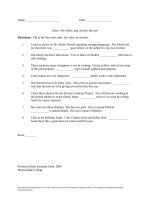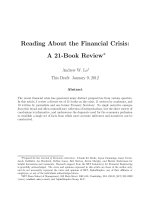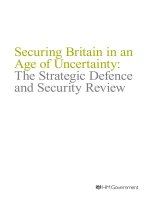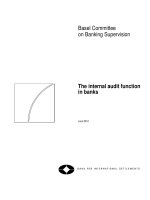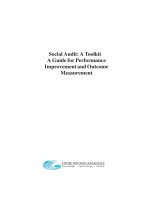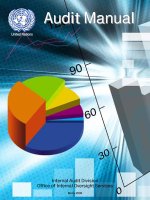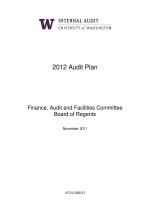acca test book Audit and Internal Review doc
Bạn đang xem bản rút gọn của tài liệu. Xem và tải ngay bản đầy đủ của tài liệu tại đây (349.17 KB, 8 trang )
PAGE 3
Paper 2.6
Audit and Internal Review
(INT)
3.6 Advanced Corporate Reporting
3.1 Audit and Assurance Services
2.5 Financial Reporting
1.1 Preparing Financial Statements
2.6 Audit and Internal Review
AIM
To develop knowledge and understanding
of the audit process and its application in
the context of the external regulatory
framework and for business control and
development.
OBJECTIVES
On completion of this paper, candidates
should be able to:
• understand the nature, purpose and
scope of auditing and internal review,
including the role of external audit and
its regulatory framework, and the role of
internal audit in providing assurance on
risk management and on the control
framework of an organisation
• identify risks, describe the procedures
undertaken in the planning process,
plan work to meet the objectives of the
audit or review assignment and draft
the content of plans
• describe and evaluate accounting and
internal control systems and identify and
communicate control risks, potential
consequences and recommendations
• explain and evaluate sources of
evidence, describe the nature, timing
and extent of tests on transactions and
account balances (including sampling
and analytical procedures) and design
programs for audit and review
assignments
• evaluate findings, investigate
inconsistencies, modify the work
program as necessary, review
subsequent events, and justify and
prepare appropriate reports for users
within and external to the organisation,
including recommendations to enhance
business performance
• discuss and apply the requirements of
relevant International Standards on
Auditing
• demonstrate the skills expected in Part 2.
POSITION OF THE PAPER IN THE
OVERALL SYLLABUS
Paper 2.6 builds on the knowledge and
understanding developed by Paper 1.1
Preparing Financial Statements and to a
limited extent Paper 1.2 Financial
Information for Management.
Candidates will be expected to be familiar
with Paper 2.5 Financial Reporting,
including the requirements of the
accounting standards examined within it.
They will also be expected to be familiar
with Paper 2.1 Information Systems.
Paper 2.6 provides the knowledge and
understanding of the audit process which is
then developed in Paper 3.1 Audit and
Assurance Services.
SYLLABUS CONTENT
1 Audit framework
(a) The development and changing nature
of audit.
(b) Statutory audits, accountability,
stewardship and agency.
(c) Professional ethics and codes of
conduct, their application to external
audit and internal audit,
responsibility for fraud and error.
2 Internal audit and internal review
(a) The role of internal audit and internal
review and their relationship with:
(i) corporate governance
(ii) risk management
(iii) organisational control
(iv) corporate objectives.
PAGE 4
Audit and Internal Review (INT) (Continued)
(b) Scope and functions of internal
audit, the nature and extent of
internal audit assignments.
(c) Outsourced internal audit functions.
(d) The nature and extent of internal
review assignments including
operational, systems, value for
money and financial reviews.
3 Regulation
(a) International Standards on Auditing:
(i) their development and role
(ii) their relationship with national
standards.
(b) Auditors:
(i) regulation and supervision
(ii) their relationship with governments
(iii) the role of IFAC.
4 Planning and risk
(a) Objectives of audit and review
assignments, the relevance of
stakeholder dialogue.
(b) Communicating the objectives of
audit and review assignments.
(c) Analytical procedures.
(d) Risk assessment.
(e) Materiality, tolerable error, and
sample sizes.
(f) Design and documentation of the
plan and work program.
(g) Co-ordination of the work of others.
(h) Information technology in planning
and risk assessment.
5 Internal control
(a) Objectives of internal control systems.
(b) Inherent weaknesses in internal
control systems.
(c) The use of internal control systems
by auditors.
(d) Transaction cycles (revenue, purchases,
payroll, inventory, capital expenditure).
(e) The evaluation of internal control
systems by auditors including
internal control checklists and tests
of control.
(f) Communication with management.
6 Other audit and internal review evidence
(a) Financial statement assertions: assets,
liabilities, income and expenditure,
including accounting estimates.
(b) Assertions reported on and opinions
provided in review assignments.
(c) Analytical procedures as substantive
evidence.
(d) Balance and transaction testing.
(e) Computer-assisted audit techniques,
their uses and limitations.
(f) Management representations.
(g) Audit sampling and other selective
testing procedures.
(h) Subsequent events reviews.
(i) Going concern reviews.
(j) The overall review of evidence
obtained.
(k) Modifications to the plan and work
program in the light of findings.
7 Reporting
(a) Format and content of unmodified
and modified external audit reports
on financial statements.
(b) Format and content of review reports
and other reports on assignment
objectives.
(c) Recommendations for the
enhancement of business performance.
EXCLUDED TOPICS
The audit of groups is not examinable at
this level. Candidates should be aware of
the content, wording and meaning of
external audit reports and they may be
asked to prepare the explanatory
paragraphs for inclusion in a modified audit
report. However, candidates are not
expected to draft full external audit reports.
Exposure Drafts (EDs) are not examinable
for Paper 2.6.
KEY AREAS OF THE SYLLABUS
The key topic areas are as follows:
• professional ethics as they apply to
accountants working in public practice
and in business
• risk assessment and the response to
assessed risks for external auditors
• the role of internal audit in risk
management and corporate governance
• internal controls
• substantive audit evidence.
PAGE 5
Audit and Internal Review (INT) (Continued)
APPROACH TO EXAMINING THE
SYLLABUS
The examination is a three hour paper
constructed in two sections. The bulk of
the questions will be discursive but some
questions involving computational elements
will be set from time to time.
Section A is compulsory. The questions
will cover the key elements of the syllabus
relevant to both internal and external audit
assignments. Section B requires
candidates to answer two out of three
questions. The questions will cover all
areas of the syllabus.
Number
of marks
Section A: 3 compulsory
questions (which may be
scenario based)
(no single question will exceed
25 marks) 60
Section B: Choice of 2 from 3
questions (20 marks each) 40
100
ADDITIONAL INFORMATION
This paper encompasses:
1 Internal review, which may be provided
either by internal auditors or may be
outsourced to external auditors.
2 External audit
References to audit and auditors mean
both internal and external audit and
auditors, except where otherwise indicated.
Candidates need to be aware that
questions involving knowledge of new
examinable regulations will not be set until
at least six months after the last day of the
month in which the regulation was issued.
The Study Guide provides more detailed
guidance on the syllabus. Examinable
documents are listed in the ‘Exam Notes’
section of student accountant.
RELEVANT TEXTS
There are a number of sources from which
you can obtain a series of materials written
for the ACCA examinations. These are
listed below:
Foulks Lynch – ACCA's official publisher
Contact number: +44 (0)20 8831 9990.
Website: www.foulkslynch.com
Accountancy Tuition Centre (ATC)
International
Contact number: +44 (0)141 880 6469.
Website: www.ptc-global.com
BPP
Contact number: +44 (0)20 8740 2211.
Website: www.bpp.com
The Financial Training Company
Contact number: +44 (0)174 785 4302.
Website: www.financial-training.com
Wider reading is also desirable, especially
regular study of relevant articles in ACCA's
student accountant.
STUDY GUIDE
1 The Nature, Purpose and Scope of
Audit and Review
Explain the:
(a) Nature and development of audit
and review
(b) Concepts of accountability,
stewardship and agency
(c) Concepts of materiality, true and fair
presentation and reasonable
assurance
(d) Reporting as a means of
communication to different
stakeholders
(e) Need for auditors to communicate
with those charged with governance
(f) High level of assurance provided by
audit assignments; the moderate
level of assurance provided by
review assignments; assignments in
which no assurance is provided.
NB: Students are expected to be aware
of the nature and purpose of non-
financial review services as described in
Session 6. Internal review questions
may deal with these subjects, as well as
financial and systems reviews in the
context of companies and small not-for-
profit organisations
These articles and other communications
from the Examiner can be downloaded via
the student section of
www.accaglobal.com.
PAGE 6
Audit and Internal Review (INT) (Continued)
2 Statutory Audits
Describe the:
(a) Regulatory framework in which
statutory audits take place
(b) Development and status of
International Standards on Auditing
and their relationship with national
standards
(c) Reasons for, and mechanisms for,
the regulation of auditors by
governments and other regulatory
agencies
(d) Types of opinion provided in
statutory audit assignments
(e) Limitations of statutory audits
3 Internal Audit and Review I
Explain the:
(a) Meaning of corporate governance
and describe corporate governance
objectives and the major elements
of good corporate governance
practice
(b) Development and role of internal
audit in achieving corporate
objectives and as part of good
corporate governance practice
(c) Relative merits of out-sourcing
internal audit and internal review
services to external auditors and
others, and the associated problems
(d) Difference between the role of
external audit and internal audit
(Note: Candidates are expected to be
aware of the major areas covered by
the major international codes of
corporate governance (such as
OECD) and in particular, the
recommendations made in relation
to internal audit.)
4 Internal Audit and Review II
Explain and illustrate the:
(a) Function of internal audit in the
context of corporate risk
management and organisational
control
b) Elements and use of the commonly
recognised control frameworks and
control components (such as COSO
and COCO)
5 Internal Audit and Review III
Describe the:
(a) Elements of best practice in the
structure and operations of an
internal audit function
(b) Scope of internal audit work and the
limitations of the internal audit
function
(c) Types of report provided in internal
audit and internal review assignments
6 Internal Audit and Internal Review IV
Describe and illustrate the:
(a) Nature and purpose of internal
review assignments including:
(i) value for money
(ii) best value
(iii) IT
(iv)financial
(b) Nature and purpose of operational
internal review assignments
including:
(i) procurement
(ii) marketing
(iii) treasury
(iv) HR
7 Professional Ethics and
Professional Codes of Conduct I
(a) Describe the sources of, and
enforcement mechanisms associated
with, professional ethics and
professional codes of conduct
(b) Define the fundamental concepts of
professional ethics
(c) Define the detailed requirements of,
and illustrate and analyse the
application of, professional ethics in
the context of independence,
objectivity and integrity
(d) Distinguish between the elements of
professional ethics applicable to
internal auditors and those
applicable to external auditors
(e) Describe the responsibilities of internal
and external auditors for the prevention
and detection of fraud and error and
in relation to laws and regulations
8 Professional Ethics and
Professional Codes of Conduct II
(a) Describe the requirements of
professional ethics and other
requirements in relation to the
acceptance of audit and review
assignments, including situations in
which there is an imposed limitation
in audit scope
PAGE 7
Audit and Internal Review (INT) (Continued)
(b) Define the detailed requirements of,
and illustrate and analyse the
application of, professional ethics in
the context of confidentiality and
conflicts of interest
(c) Describe the importance of
engagement letters and describe
their contents
9 Preliminary Planning Procedures
(a) Distinguish between risk-based,
procedural and other approaches to
audit and review work
(b) Describe the sources and nature of
information gathered in planning
audit and review assignments
(c) Describe the purpose of analytical
procedures in planning and illustrate
the application of such procedures
(d) Describe the components of risk and
the use of information technology in
risk analysis
(e) Illustrate and explain the importance
of the application of risk analysis
(f) Define and illustrate the concepts of
materiality and tolerable error
(g) Evaluate misstatements
10 The Work Plan, the Work Program and
Documentation
(a) Describe and illustrate the contents
of work plans, work programs and
working papers
(b) Describe the nature of
documentation required for different
types of assignment
(c) Explain the importance of
documentation
(d) Illustrate the use of information
technology in the audit
11 The Work of Others
Describe the:
(a) Extent to which external auditors are
able to rely on the work of:
(i) internal audit
(ii) experts
(iii) service organisations
and recognise where reliance is needed
(b) Extent to which internal auditors are
able to rely on the work of:
(i) experts
(ii) service organisations
(c) Conditions that must be met before
reliance can be placed on the work
of others and the planning
considerations in co-ordinating the
work of others
(d) Division of responsibilities between
auditors and others
(e) Extent to which reference to the
work of others can be made in audit
and review reports
12 Internal Control I
(a) Describe the objectives of internal
control systems and the responsibility
for internal control systems in the
context of organisational objectives
(b) Describe the importance of internal
control to auditors
(c) Describe and illustrate the
limitations of internal control
systems in the context of fraud and
error
(d) Explain the need to modify the audit
plan in the light of the results of
tests of control
(e) Distinguish between tests of controls
and substantive tests
13 Internal Control II – Revenue,
Purchases and inventory
(a) Describe, illustrate and analyse how
internal control systems over revenue,
purchases and inventory cycles
operate in both large and small entities
(b) Describe and illustrate the use by
auditors of internal control checklists
for revenue, purchases and inventory
transaction cycles
(c) Describe and tabulate tests of
control of revenue, purchases and
inventory for inclusion in a work
program
(d) Explain and illustrate how structural
and operational weaknesses in
revenue, purchases and inventory
systems should be reported to
management and how
recommendations should be made
14 Internal Control III – Revenue
Expenditure and Capital Expenditure
(a) Describe, illustrate and analyse how
internal control systems over revenue
and capital expenditure transaction
cycles operate in both large and
small entities
PAGE 8
Audit and Internal Review (INT) (Continued)
(b) Describe and illustrate the use by
auditors of internal control checklists
for revenue and capital expenditure
transaction cycles
(c) Describe and tabulate tests of
control of revenue and capital
expenditure for inclusion in a work
program
(d) Explain and illustrate how structural
and operational weaknesses in
revenue and capital expenditure
systems should be reported to
management and how
recommendations should be made
15 Internal Control IV – Payroll
(a) Describe, illustrate and analyse how
internal control systems over the
payroll transaction cycle operate in
both large and small entities
(b) Describe and illustrate the use by
auditors of internal control checklists
for the payroll transaction cycle
(c) Describe and tabulate tests of
control of payroll for inclusion in a
work program
(d) Explain and illustrate how structural
and operational weaknesses in
payroll systems should be reported
to management and how
recommendations should be made
16 Internal Control V – Bank and Cash
(a) Describe, illustrate and analyse how
internal control systems over the
bank and cash transaction cycle
operate in both large and small
entities
(b) Describe and illustrate the use by
auditors of internal control checklists
for the bank and cash transaction
cycle
(c) Describe and tabulate tests of
control of bank and cash for
inclusion in a work program
(d) Explain and illustrate how structural
and operational weaknesses in bank
and cash systems should be reported
to management and how
recommendations should be made
NB: For items 13–16, an
understanding of IT issues and
computer controls is required
17 Other Audit and Review Evidence I
(a) Describe the sources and relative
merits of different types of evidence
available
(b) Describe the financial statement
assertions commonly reported on
and the principles and objectives of
balance and transaction testing
(c) Distinguish between the interim and
the final audit
(d) Describe and illustrate how
analytical procedures are used as
substantive procedures
(e) Explain the problems associated
with the audit and review of
accounting estimates
(f) Describe the types of evidence
available in smaller entities
(g) Evaluate the quality of evidence
collected
18 Other Audit and Review Evidence II –
Receivables and Prepayments
(a) Describe and tabulate for inclusion
in a work program the substantive
procedures, including direct
confirmation of accounts receivable,
used in obtaining evidence in
relation to receivables and
prepayments, and the related
income statement entries
(b) Explain the purpose of substantive
procedures in relation to financial
statement assertions concerning
receivables and prepayments
19 Other Audit and Review Evidence III –
Inventory
(a) Explain the importance of inventory
(b) Describe inventory counting
procedures
(c) Explain cut-off
(d) Describe and tabulate for inclusion
in a work program the substantive
procedures used in obtaining
evidence in relation to inventory,
including the auditor's attendance at
inventory counting
(e) Explain the purpose of substantive
procedures, including direct
confirmation of inventory held by
third parties, in relation to financial
statement assertions concerning
inventory
PAGE 9
20 Other Audit and Review Evidence IV –
Current Liabilities and accruals
(a) Describe and tabulate for inclusion
in a work program the substantive
procedures used in obtaining
evidence in relation to current
liabilities and accruals, and the
related income statement entries
(b) Explain the purpose of substantive
procedures, including supplier
statement reconciliations and direct
confirmation of accounts payable, in
relation to financial statement
assertions concerning current
liabilities and accruals
21 Other Audit and Review Evidence V –
Bank and cash
(a) Describe and tabulate for inclusion
in a work program the substantive
procedures including bank
confirmation reports used in
obtaining evidence in relation to
bank and cash, and the related
income statement entries
(b) Explain the purpose of substantive
procedures in relation to financial
statement assertions concerning
bank and cash
22 Other Audit and Review Evidence VI –
non-current assets and long-term
liabilities
(a) Describe and tabulate for inclusion
in a work program the substantive
procedures used in obtaining
evidence in relation to non-current
assets and non-current liabilities and
the related income statement entries
(b) Explain the purpose of substantive
procedures in relation to financial
statement assertions concerning
non-current assets and non-current
liabilities
23 Other Audit and Review Evidence VII
(a) Explain the need for sampling
(b) Distinguish between statistical and
non-statistical sampling
(c) Describe and illustrate the
application of the basic principles of
statistical sampling and other
selective testing procedures
(d) Describe and illustrate the use of
computer assisted techniques in
obtaining evidence
(Note: candidates will not be
required to perform detailed
sampling calculations).
24 Going Concern Reviews
(a) Explain the importance of going
concern reviews
(b) Describe the procedures to be
applied in performing going concern
reviews
(c) Describe the disclosure requirements
in relation to going concern issues
(d) Describe the reporting implications
of the findings of going concern
reviews
25 Audit Finalisation and the
final review
Describe and explain the:
(a) Quality of management
representations as audit evidence
(b) Circumstances in which obtaining
management representations is
necessary and the matters on which
representations are commonly
obtained
(c) Purpose of the subsequent events
review
(d) Procedures to be undertaken in
performing a subsequent events
review
(e) Importance of the overall review of
evidence obtained
(f) Problems associated with the
application of accounting treatments
(g) Significance of unadjusted
differences
26 Reporting I
(a) Describe, illustrate and analyse the
format and content of unmodified
and modified statutory audit reports
27 Reporting II
Describe, illustrate and analyse the
format and content of:
(a) Internal review reports and other
reports dealing with
recommendations for the
enhancement of business
performance
Audit and Internal Review (INT) (Continued)
PAGE 10
28 Not-For-Profit Organisations
(a) Apply audit and review techniques to
small not-for-profit organisations
(b) Explain how the audit and review of
small not-for-profit organisations
differs from the audit and review of
for-profit organisations
Audit and Internal Review (INT) (Continued)
